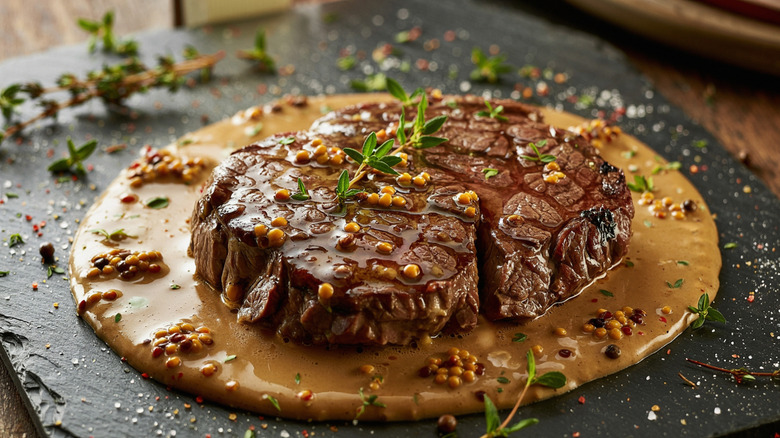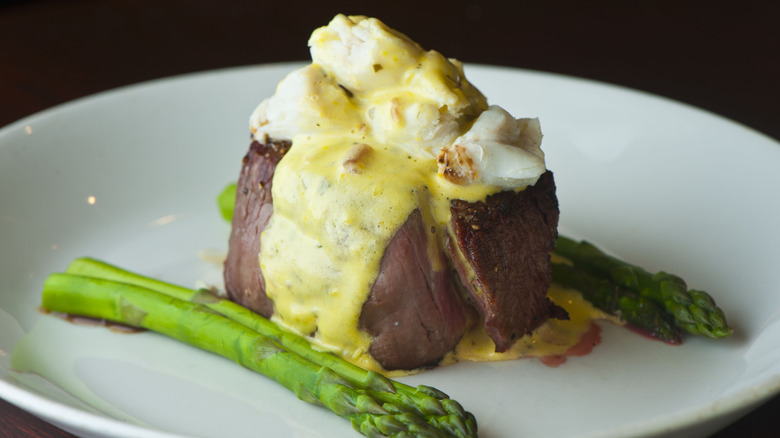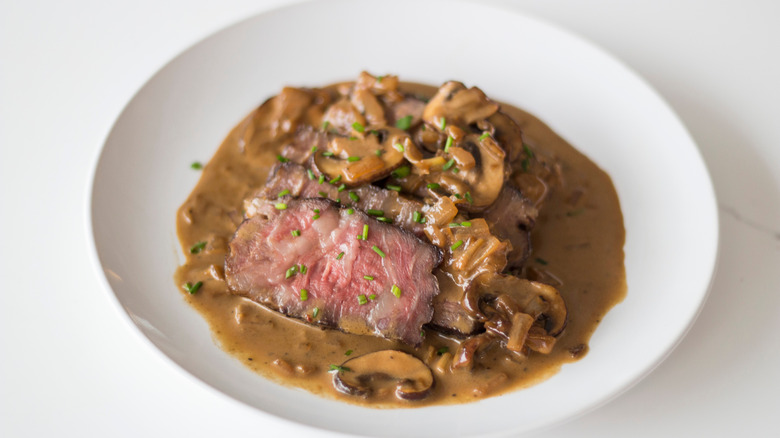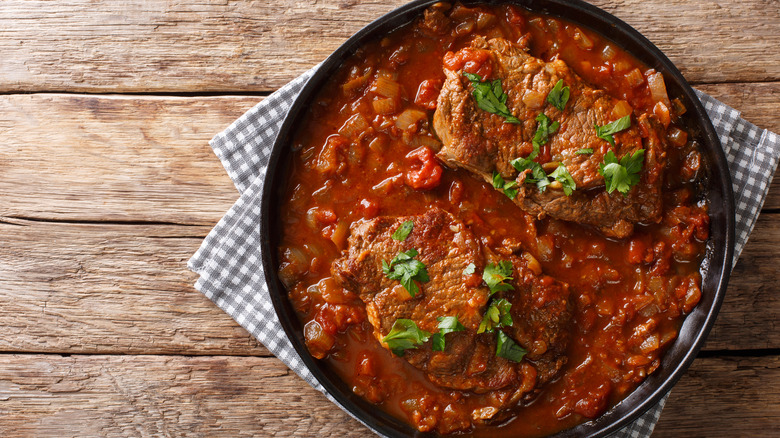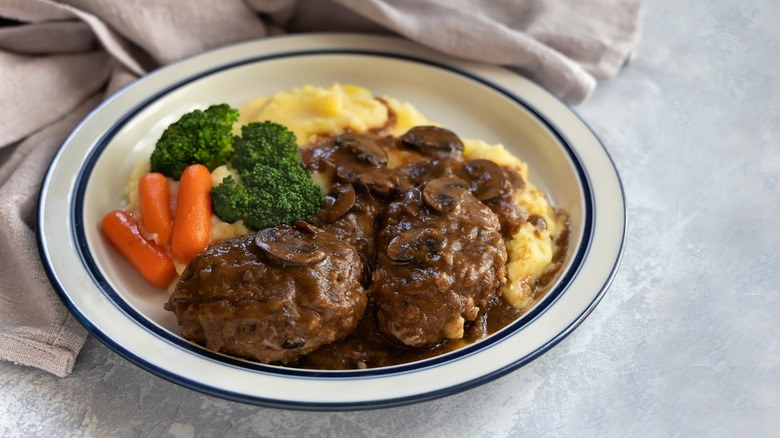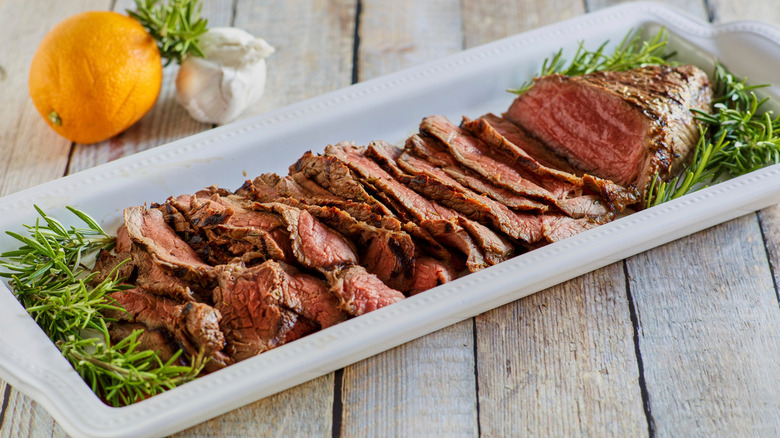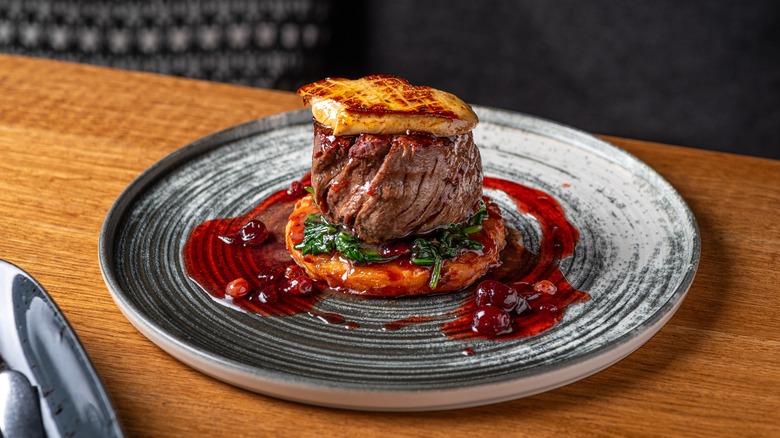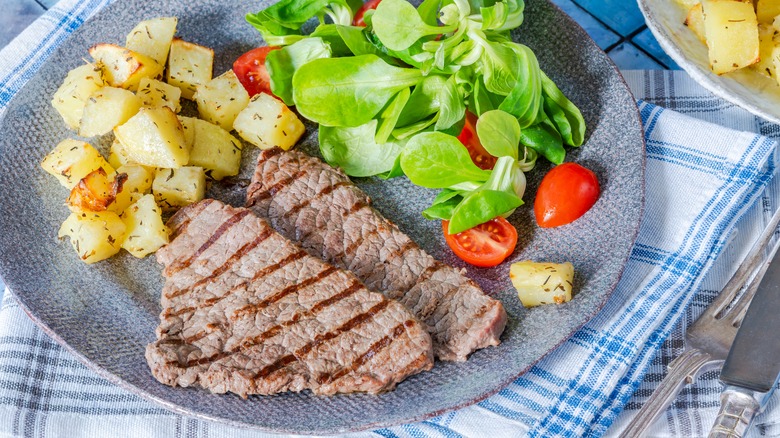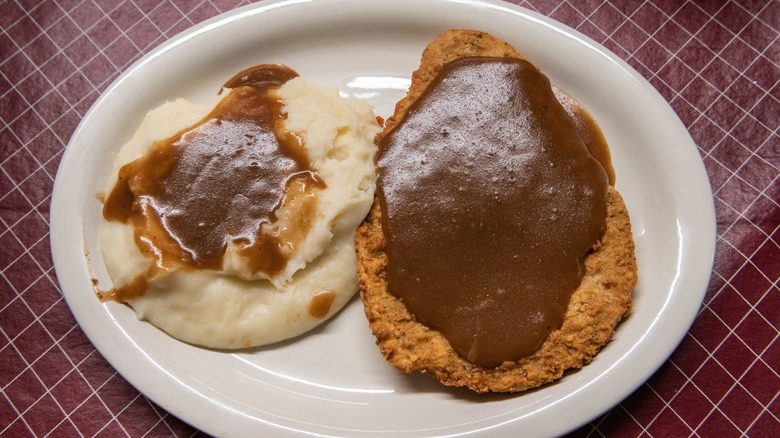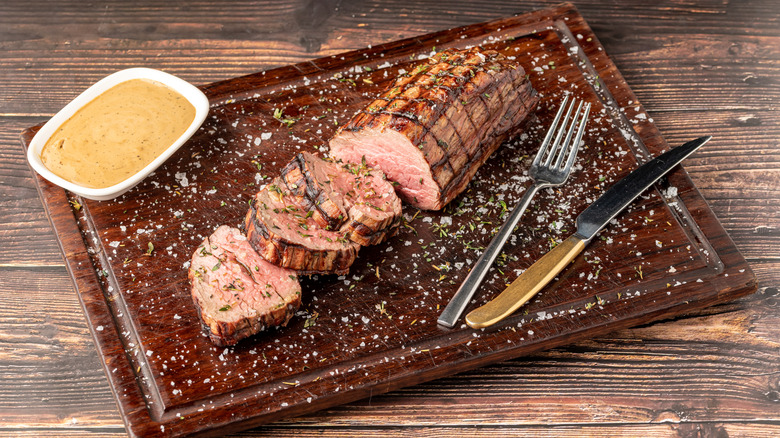10 Classic Steak Dishes That Vanished From Restaurant Menus
There are few things as classic as a good steak. A seared hunk of red meat on a plate, served with your favorite sides and a good glass of red wine? It's kinda the meal to end all meals, y'all. These days, to order the dish is to honor the meat in front of you, and chefs are aware of the demands of customers to create steak out of restaurant-worthy cuts which sing with flavor without any sauces or toppings. However, in all of this worship of the meat itself, some classic steak dishes have been nudged off menus entirely — and we've lost a lot of great steak meals that used to make diners very happy.
In our personal opinion, a lot of these steak dishes deserve a revival. Things like steak Diane, steak Oscar, and Tournedos Rossini are seen today as fussy and old-school, but they highlight parts of beef's flavor profile that can be lost when it's served on its own. Elsewhere, steak dishes like minute or Salisbury steak that once served to feed cost-conscious customers have been lost to the sands of time. Well, it's time to drag them back up.
1. Steak Oscar
Depending on how you look at things, steak Oscar is either a delightful mass of different flavors or a dish that's way too fussy. Either way, it's an experience. Steak Oscar is a popular spin on veal Oscar, a dish which is fittingly named after Oscar II, the king of Sweden who ruled between 1872 and 1907. The story goes that in 1897, Oscar II was served a dish that he liked so much that it immediately took on his name, and both veal and steak Oscar were born.
The original veal Oscar starts with veal cutlets, which are sprinkled with flour and sautéed in butter until browned on both sides. These cutlets are then topped with a combination of wine, onion, and crabmeat, which come together to create a flavorful, umami-packed mélange. A pair of asparagus stalks are placed on top as a finishing touch. Steak Oscar simply swaps out veal for beef, in a move that was likely taken to make it more appealing to the masses, and it quickly became a staple on fancy menus. In recent times, however, you're unlikely to see it in many restaurants, and it feels like a dish from a bygone era. We'd make an argument, though, that you could call this dish the original Surf & Turf, what with its combo of seafood and beef.
2. Steak Diane
It's hard to talk about classic steak dishes without bringing up steak Diane. This dish is a post-war invention that became a staple in New York City's food scene. It's believed to have been brought to the city by the Drake Hotel's Beniamino Schiavon, although it seems to be closely related to other French steak dishes like steak au poivre. The distinguishing factor for this dish, though, was that the booze the steak was doused in was finished off with flames at the table by the waiter before it was served. This mid-century mode of service was all the rage, with other dishes like bananas Foster and fettuccine Alfredo also getting the same treatment.
Sadly, steak Diane began to lose its luster as food trends began to change, and by the 1980s it was a mere memory in the minds of folks who once enjoyed its boozy, indulgent nature. It's a shame it's largely gone, because it's hard to beat a classic steak Diane. The combination of mushrooms, shallots, tomato paste, beef broth, and steak create a deeply savory flavor, while the cognac that finishes it off gives it all a serious intensity.
3. Swiss steak
Where do you think Swiss steak comes from? We're not even gonna answer that one, guys, we know the bit. However, it might surprise you to hear that this mid-century classic may not have originated in Switzerland after all. While the name of course points towards it hailing from the mountainous European country, others have claimed that it's derived from the technique used to make it. The meat is first "swissed," which involves beating, rolling, or puncturing it with needles or prongs to tenderize it. Swissing is a technique that's traditionally used to soften fabrics, but here it's the beef that's benefitting — afterwards, it's cooked in a rich gravy with root vegetables and tomatoes, before being served over mashed potatoes.
Swiss steak appears to have originated during the First World War, but it began gaining traction in the United States a few decades later. Interestingly, it was Reynold's aluminum foil that made it popular as a home-cooked dish, as the company advertised its product by suggesting that you cook Swiss steak on it in a pan. We're not sure if the restaurants that served it did that too, but it was a staple of menus for a while there, before other dishes came along and swept it away.
4. Salisbury steak
These days, Salisbury steak is one of those dishes you only see on menus in seriously old-fashioned restaurants — and in places that are keeping with the times, it's been banished. We can understand this, given that it's a menu item that was invented during the Civil War. The early form of Salisbury steak was created by James Henry Salisbury, a doctor who proposed that a diet rich in beef was a potential cure for digestive ailments. While this beginning for the dish was slightly medicinal, its flavor soon helped it thrive. When the First World War rolled around and people started to lean away from foods with Germanic names, Salisbury steak became a popular replacement for Hamburg steaks, or hamburgers.
Whether or not you consider Salisbury steak actual steak, there's no denying how much people love it. However, by the middle of the 20th century, it started to turn into its current form, as a dish that's more likely to be enjoyed as a TV dinner than at a restaurant. Although old-school diners will sometimes serve it (sometimes under the name "chopped steak"), it's arguably viewed as substandard to the fully formed version.
5. London broil
London broil sounds like a hot, sultry summer in the UK's capital city, but it's actually a pretty delectable steak dish. If you were thinking that it refers to the cut of the meat itself, though, you'd be mistaken. Oh, and it's not really British, either. London broil is instead an American creation, and started to pop up in cookbooks in the 1930s. It soon made the leap to become a restaurant dish, before it fell out of favor and became a retro classic.
We've talked a lot about what this dish isn't, though — so what is it? London broil is made using flank steak, which is marinated for several hours or overnight. It can also be made with other tougher, cheaper cuts of meat like top round. The idea is that by marinating these chewier cuts, you can achieve a tender result without having to pay for a piece of beef with loads of marbling. The marinated steak is then (as the name suggests) broiled, and once cooked it's sliced against the grain to make sure every mouthful is as meltingly soft as possible. It's the perfect combo of flavor, texture, and affordability.
6. Tournedos Rossini
If you ever see tournedos rossini on a restaurant menu, you know that you're somewhere pretty fancy — and likely incredibly old-fashioned. This example of fine French cuisine has taken a major back seat in recent years, but it used to be the classiest thing you could order. Tournedos Rossini is said to have been created at the Café Anglais in Paris by chef Adolphe Dugléré, although other people attribute it to fellow chef Casimir Moissons, and others still state that it was invented by Marie-Antoine Carême. Regardless of who first cooked it, though, what is generally accepted that it was named after 19th century composer Gioachino Rossini, in a bid to invent a dish that befitted his brilliance.
Anyone who's tried it will know how brilliant it can taste, too. Tournedos rossini is a rich, flavorful combination of steak, foie gras, truffles, and Madeira sauce. The beef is typically filet mignon, which has been sautéed in butter. The steak rests on a circle of toasted bread, with the foie gras balanced on top. While it's a dish that certainly impresses, it's both tricky and expensive to make — and the use of foie gras does give it an outdated and slightly controversial feel. Perhaps this is why you rarely see it anywhere these days.
7. Minute steak
One of our favorite things about minute steak is how literal it is. This steak dish (which is also known as cube steak) is named after how long it typically takes to cook, thanks to technology that emerged way earlier than you probably think. Minute steak was born in the 19th century, when cowboys and ranchers needed to find a way to break down tougher pieces of beef and make them edible. Meat tenderizers, which consisted of needles that would puncture the beef to make them easier to chew through, were invented, making most cuts of meat much quicker to cook.
The minute steak was born, and it took off fast. It became a steak dish that you'd find in restaurants and supermarkets during the 20th century, and it was also commonly used in more complicated or elaborate meals. Fairly soon, though, people started to become more savvy about steak, realizing that true tenderness was achieved by sourcing higher-quality cuts or bathing the meat in flavorful marinades. Minute steak is still readily available in supermarkets, but in restaurants you're fairly unlikely to find it these days, as most eateries focus on offering the best meat possible.
8. Delmonico steak
Delmonico steak is a funny old thing, and trying to figure out exactly what it is is weirdly difficult. This bygone steak dish gained its name from the legendary New York steakhouse Delmonico's, which opened its doors for the first time way back in 1837. Delmonico steak became its house specialty, and has the distinction of sitting on its menu to this day. However, when its original location shut in 1923, imitators sprung up around the country, all of them promising a "Delmonico steak," presumably cooked in the original restaurant's style.
However, the thing is that Delmonico steak isn't a specific cut, and nor is it prepared in any specific fashion: It's just a name for a steak dish that sounds fancy. The only real thing that's used to determine it is its size: Delmonico steak should be big, up to two inches in thickness. Other than that, it's kinda prepared just like any other steak. This is perhaps why Delmonico steak is no longer seen anywhere, as restaurants have realized that the additional word in the name is unnecessarily fussy. Where you will find it, though, is at Delmonico's — so if you want the real thing, head down to 56 Beaver Street.
9. Country-fried steak
If you've ever had chicken-fried steak, you've eaten something similar to its country-fried version. However, you won't see country-fried steak on menus pretty much anywhere these days, although you might be lucky enough to be blessed with its presence in certain joints. Country-fried steak has its origins in Germany, and is a descendant of wiener schnitzel. It was a popular mode of preparing steak in the 1800s, with chicken-fried steak emerging slightly later on when eggs became more available.
Like chicken-fried steak, country-fried steak is essentially a piece of beef that's been coated and fried to give it a crispy exterior. However, country-fried steak is much simpler, and is generally only coated with flour before being thrown into a frying pan, while chicken-fried steak is coated in egg batter and flour. Chicken-fried steak is also generally served with a thick, white, creamy gravy, whereas the dark gravy for country-fried steak is created using the drippings from the pan it was cooked in. Despite these differences, the two dishes are often confused with each other, with their names used interchangeably — and you may well find chicken-fried steak prepared in the country-fried manner in some places.
10. Chateaubriand
Upon first glance, it kinda seems weird that you don't see chateaubriand much anymore. After all, it can be tricky to figure out exactly why this steak dish is different from a filet mignon or any other piece of beef on the menu. The difference, however, lies both in the cut of the meat itself and in the laborious preparation and cooking method which often makes it just too expensive for restaurants to justify. Chateaubriand dates back to the 19th century, and its cooking technique was pioneered by the personal chef of François-René de Chateaubriand, a French aristocrat. Chateaubriand's chef discovered that the center-cut of the fillet was one of the most tender steaks out there, and he also figured out that a slow-roasted approach works best to make it as juicy and succulent as possible.
Thus, chateaubriand was born. It was first cooked by wrapping it in cheaper steaks and roasting the combo until the interior meat was just-cooked. Nowadays, chateaubriand is generally roasted on its own before being sliced and drizzled with sauce. This is a fairly intensive way of creating it, and you also have the added issue of what to do with all those extra slices — which is why, if you see chateaubriand on a menu, it will often be for two or more people. Most of the time, though, restaurants just don't bother putting it on there.
